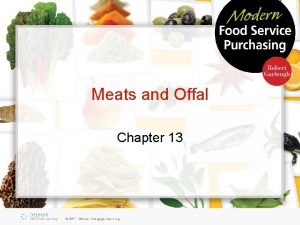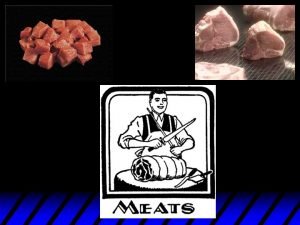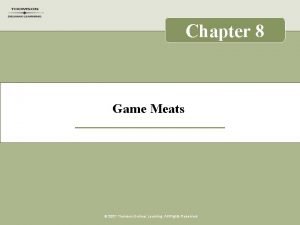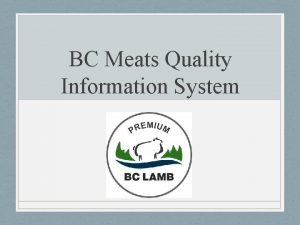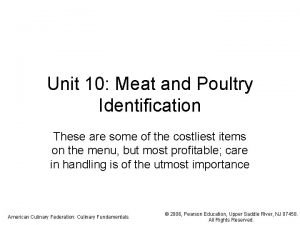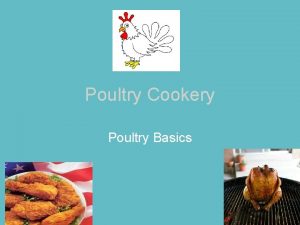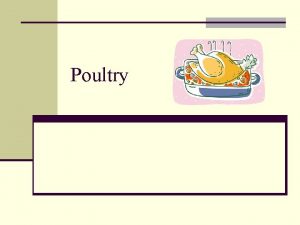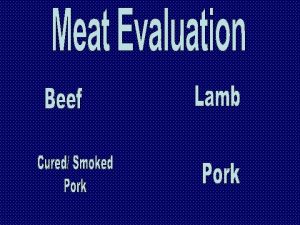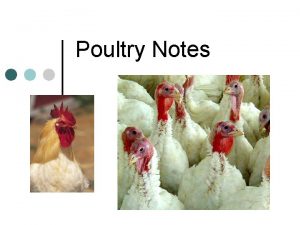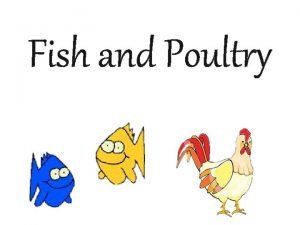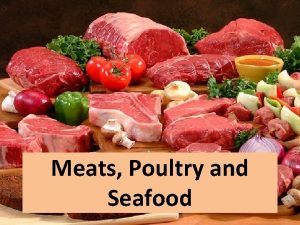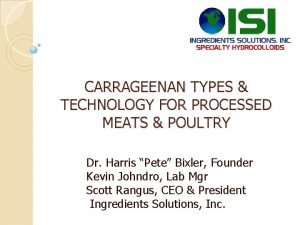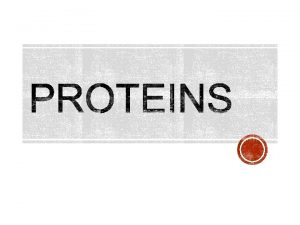Meats Poultry and Fish CHAPTER 23 1 Nutrients

















- Slides: 17

Meats, Poultry, and Fish CHAPTER 23. 1

Nutrients in Meat, Poultry, and Fish Meats, poultry, and fish provide the complete proteins your body needs. They also provide important B vitamins and a few trace minerals. Even though fat and cholesterol are nutrients, saturated and trans fat intake should be limited, watch that amount in your meat intake. Glencoe Applying Life Skills Chapter 23 Preparing Protein Foods

STRUCTURAL PROTEIN Needed for all parts of your body Collagen Ligaments Tendons Building and repairing muscles Glencoe Applying Life Skills Chapter 23 Preparing Protein Foods

ENZYMES AND HORMONES Enzymes and hormones are special proteins Aid in growth Help balance body fluids working with electrolytes and water Regulate our metabolism Glencoe Applying Life Skills Chapter 23 Preparing Protein Foods

ANTIBODIES & ENERGY Antibodies are a protein to ward off disease they weaken or destroy foreign substances in the body Can provide energy IF needed This is dangerous A body starved of carbs, will then break down your muscles to be fed. Glencoe Applying Life Skills Chapter 23 Preparing Protein Foods

ESSENTIAL “AMINO ACIDS” There are 20 “Amino Acids”. The body makes 11 of them. The remaining 9 are called Essential Amino Acids or the “Legos” of protein. We can get them from animal sources – meat, poultry and fish. Glencoe Applying Life Skills Chapter 23 Preparing Protein Foods

COMPLETE/INCOMPLETE PROTEIN Complete Protein: contains all the “Legos” or essential amino acids. Incomplete Protein: lacks one or more of the essential amino acids. Vegetarians: Need to eat plant sources that have essential amino acids (seeds, legumes, nuts and grains) Glencoe Applying Life Skills Chapter 23 Preparing Protein Foods

Nutrients in Meat, Poultry, and Fish Choose lean meat (low in fat and calories) Avoid processed meats, when you can (ex bologna, salami). Glencoe Applying Life Skills Chapter 23 Preparing Protein Foods

MEATS AND THEIR FAT! Beef—larges amount of saturated fat. Pork—contains more polyunsaturated fat. Poultry—less saturated fat than beef. Fish—contains most polyunsaturated fat. Invisible Fat—the chemical composition of food Visible Fat—the fat that you can see, layers around the meat. Marbling—small white flecks in the muscle tissue. Glencoe Applying Life Skills Chapter 23 Preparing Protein Foods

Consumer Considerations Food safety Your health Your budget when you shop for, prepare, and store meat, poultry, and fish. Glencoe Applying Life Skills Chapter 23 Preparing Protein Foods

MEATS Grading: ***Prime **Choice * Select Less-used muscles along the back are more tender. Frequently used muscles are less tender. Appearance should be light pink or red in color. Store in the refrigerator and use within 3 -4 days. Overcooked meat will be dry and “Just Right Glencoe Applying Life Skills Chapter 23 Preparing Protein Foods

STORING AND COOKING MEATS Store in the refrigerator and use within 3 -4 days. Overcooked meat will be dry and “Just Right will be juicy and flavorful When is it done? Use a meat thermometer; except hamburgers must be done all the way through. Glencoe Applying Life Skills Chapter 23 Preparing Protein Foods

POULTRY Low in fat. Mild in flavor. Light meat is leaner and milder in flavor Dark meat has more fat and stronger in flavor Appearance should be moist, plump, clean and blemish free skin. Glencoe Applying Life Skills Chapter 23 Preparing Protein Foods

STORING AND COOKING POULTRY Store in the refrigerator and use within 1 -2 days. Overcooked will be dry and flavorless, “Just Right” will be tender and juicy. When is it done? Juices will run clean. Internal temperature is 180 degrees. Glencoe Applying Life Skills Chapter 23 Preparing Protein Foods

FISH The muscles are different than meat. They have very short fibers and are arranged in layers. They are separated by thin fragile connective tissue. When it is cooked the connective tissue turns to gelatin so all fish and shellfish are very tender. The muscles flake when it is done. Glencoe Applying Life Skills Chapter 23 Preparing Protein Foods

Finfish: Have backbones and fins. Appearance: should be bright eyes, firm flesh and no odor Shellfish: Have shells instead of backbones. Cooks in a short time. Overcooked will be dry and tough, “Just Right” and it will be moist and it will flake. Glencoe Applying Life Skills Chapter 23 Preparing Protein Foods

Remember: When cooking, it is important to raise the internal temperature high enough to kill harmful bacteria. The safest way to defrost meat, poultry, and fish is in the refrigerator.
 One fish two fish red fish blue fish ride
One fish two fish red fish blue fish ride Twofish and blowfish
Twofish and blowfish Ammocoete
Ammocoete Selection and storage of meats chapter 13
Selection and storage of meats chapter 13 Which market form
Which market form Igfc meats
Igfc meats Glandular meats
Glandular meats Hidangan unggas kontinental
Hidangan unggas kontinental Meridian meats flyer
Meridian meats flyer Thomson meats
Thomson meats Lawrence meats dawson creek
Lawrence meats dawson creek A big fish swims up and swallows a small fish at rest
A big fish swims up and swallows a small fish at rest Cartilaginous fish reproduction
Cartilaginous fish reproduction Bony vs cartilaginous fish
Bony vs cartilaginous fish 5 market forms of fish
5 market forms of fish Pearson
Pearson Chapter 10 nutrition for health lesson 2 nutrients
Chapter 10 nutrition for health lesson 2 nutrients Chapter 10 lesson 2 nutrients
Chapter 10 lesson 2 nutrients



